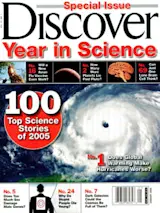Plants Once Thought Extinct Reappear Out of the Blue
In 2005 deforestation and desertification wiped out tens of millions of acres of forests and grasslands. But the year wasn't entirely bad for plants, with several species not seen for decades—or far longer—reappearing on the scene. Among the comebacks:
The Mount Diablo buckwheat, Eriogonum truncatum, a delicate pink wildflower native to northern California, was last spotted in 1936 and believed extinct. About 20 eight-inch-tall shoots of buckwheat were discovered by Michael Park, a graduate student in biology at the University of California at Berkeley, while he was surveying the southeastern flank of Mount Diablo.
Dissanthelium californicum, an eight-inch-tall species of grass once endemic to two of Southern California's Channel Islands—San Clemente and Santa Catalina—as well as Isla Guadalupe off Baja Mexico, was last seen in 1903 and presumed to be extinct. The wispy grass was observed on March 29 in a remote area of Santa Catalina Island by plant ecologist Jenny McCune of the Catalina Island Conservancy. More than 650 individual shoots have since been found. "This is surprisingly robust for a species that hadn't been encountered in over a century," says McCune. "Over 30 other plant species haven't been seen on Catalina in 50 years or more, and finding Dissanthelium gives us hope that they may still be out there."
The Judean date palm, an ancient variant of the date palm (Phoenix dactylifera), noted in historical texts for its dark, honeylike fruit, was believed to have disappeared in the first century A.D. Two-thousand-year-old seeds, recovered in the 1970s during excavations of the cliff fortress of Masada in Israel, were planted on January 25 by agronomist Elaine Solowey of the Araval Institute for Environmental Studies. Six weeks later, one seed sprouted. The date seedling is now nearly three feet tall and has 11 leaves (including one palm frond). If the plant is female, it could produce fruit in about five years. —Kathy A. Svitil














